
|
Mexican Sword
|
|
1 metre, 8 inches long Mexican sword, made of iron wood and black obsidian. |

|
15th Century Mexican Sword
|
|
25 inches long Mexican sword of the 15th century. Made of iron wood, with 10 blades fixed into the wood of the black obsidian. |
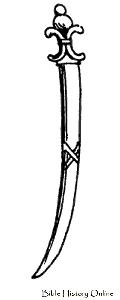
|
Hindoo Sabre
|
|
Hindoo sabre from a bas-relief of Beenjanugar and the Hussoman monument. |

|
Javanese Sword
|
|
Javanese sword from the statue of the Goddess of War at the Museum of Berlin. |

|
Assyrian Sword In Bronze
|
|
Assyrian sword in bronze from the bas-reliefs of Khorsabad, of the reign of King Sargon. B.C. 1300. |

|
Assyrian Sword
|
|
Assyrian sword from a bas-relief from a palace in Nineveh, of the reign of Sardanapalus, B.C. 1000. |

|
Persian Sword And Sheath
|
|
Ancient Persian sword and sheath from an antique group, Mithras sacrificing a bull. |

|
Ancient Persian Sword
|
|
Ancient Persian sword. Cast from a bas-relief of Persepolis from British Museum and Louvre. |

|
Egyptian Scimitar
|
|
Ancient Egyptian scimitar. |

|
Egyptian Sword
|
|
Ancient Egyptian sword. |

|
Greek Sword Called Gallo Greek
|
|
Ancient bronze Greek sword called Gallo-Greek with its sheath. 25 inches. Found in department of Uzés, Museum of Artillery, Paris. |

|
Bronze Greek Sword
|
|
Ancient bronze Greek Sword, 19 1/2 inches from Museum of Mayence. |

|
Greek Sword In Bronze
|
|
Ancient Greek sword in bronze, 32 inches. from Museum of Artillery in Paris. |

|
Dacian Sword From The Trajan Column
|
|
Ancient Dacian sword copied from the Trajan column. |
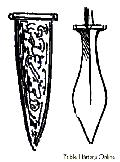
|
Roman Sword Of Iron
|
|
Ancient Roman sword of iron worn with belt called parazonium. 10inches in length, with bronze sheath. A cast of this is in the Museum of Artillery in Paris. |

|
Roman Sword-Blade In Iron
|
|
Ancient Roman sword-blade in iron. 19inches in length found at Mayence from Museum of Artillery in Paris. |

|
Roman Sword In Iron
|
|
Roman sword in iron, 22 inches in length found at Bingen from Sollen collection. |

|
Roman Iron Sword
|
|
Roman sword in iron, 23 inches in length from Sollen collection. |

|
Roman Sword In Iron With Armourers Mark
|
|
Ancient Roman sword in iron, 25 inches in length. Armourers mark is Sabini. A cast of it is in the Museum of Artillery in Paris. |

|
Roman Sword With Bronze Hilt
|
|
Ancient Roman sword in iron, 26 inches in length. Hilt is ornamented with bronze. Found at Bingen from Collection of Burgomaster Sollen. |

|
Poniard Or Short Sword
|
|
Poniard or short sword in bronze. Found in a lake dwelling at Peschiera. From Cabinet of Antiquities at Vienna. |

|
German Sword Found Near Augsburg
|
|
German sword 27 inches long found near Augsburg. The flat part of the hilt is pierced with holes, which shows that the handle must have been mounted in either wood, bone, horn or metal. From Museum of Sigmaringen. |

|
German Sword In Bronze
|
|
German sword in bronze metal, 22 inches long. Pommel is ornamented with eagle head. From Museum of Cassel. |

|
Bronze German Sword
|
|
German swords in bronze, 31 inches long. The pommels and hilts are of bone and bronze, some entirely of bone. Found in the tombs of Hallsatt. The points are not sharp. From Cabinet of Antiquities at Vienna. |

|
Short German Sword
|
|
Short German sword in bronze. From Museum of Hanover. |

|
Gallic Sword In Bronze
|
|
Gallic sword in bronze, 18 1/2 inches long. Found in the Seine at Paris. Museum of Artillery in Paris. |

|
Gallic Sword
|
|
Gallic sword from a bas-relief fitted into the pedestal of the Melpomene of the Louvre. |

|
British Bronze Sword
|
|
British bronze sword that is very like the German and Scandinavian weapons, and may easily have been Danish. Bronze Age. |

|
British Sword Blade Called Gwaew-Fon
|
|
British sword-blade in bronze, called Gwaew-fon. Bronze Age. From the Meyrick Collection. |

|
British Sword Blade In Bronze
|
|
British sword blade in bronze, found in Ireland. Bronze Age. From Meyrick collection. |

|
Danish Sword In Bronze
|
|
Danish sword in bronze with very remarkable workmanship, 37 inches in length. Bronze Age. From Copenhagen Museum. |

|
Bronze Danish Sword
|
|
Danish sword in bronze, 35 inches in length. Bronze Age. From the Copenhagen Museum. |

|
Small Germanic Sword
|
|
Small Germanic sword, 16 1/2 inches length. Blade is iron, hilt is in bronze. Found in the cemetery at Hallstatt. From Cabinet of Antiquities in Vienna. |

|
Germanic Sword In Iron
|
|
Germanic sword in iron, 37 inches in length. Point of blade is rounded. Found at Langeneslingen. From Sigmaringen Museum. |

|
Frankish Sword Of The Merovingian Epoch
|
|
Frankish sword of the Merovingian epoch, 30 inches in length with sharp point. From Museum of Artillery, Paris. |

|
Germanic Sword With Sheath
|
|
Germanic sword with sheath, found in the tomb of Childeric I (457-481). Preserved in the Museum of Louvre, Paris. There is an error in the mounting of this sword, where in the one who restored it placed the pommel close to the blade and not at the end of the hilt. |
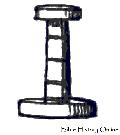
|
Haft Of Merovingian Sword
|
|
Haft of Merovingian sword. |

|
Pommel Of Sword
|
|
Pommel of sword attributed to Childeric I. |
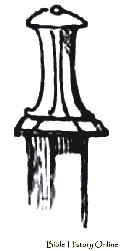
|
Haft Of Germanic Sword
|
|
Haft of Germanic sword, found at Peiting in Bavaria. |

|
Germanic Or Slavonic Sword
|
|
Germanic or Slavonic sword, square at the point, belonging to the 6th century. Copied from the bas-relief of a diptych that is in the treasury of the Cathedral of Halberstadt. |

|
Burgundian Sword In Iron
|
|
Burgundian sword in iron. 3 ft 3 inches in length including the haft. A cast is in the Museum of Artillery in Paris. The Museum of Saint Germain possesses similar swords. |

|
34 Inches Sized Germanic Sword In Iron
|
|
Germanic sword in iron, 34 inches in length. Found in a tomb in Hallstatt cemetery. From Cabinet of Antiquities in Vienna. |

|
Danish Sword In Iron With Scramasax Shape
|
|
One edged Danish sword in iron, 3 feet in length with scramasax like shape. From Museum of Copenhagen. |

|
44 Inches Sized Danish Sword
|
|
44 inches sized, one edged Danish sword in iron. Resembles the Frankish swords of the Merovingian epoch. From Museum of Copenhagen. |

|
Danish Two Edged Sword With Deeply Grooved Blade
|
|
Ancient Danish two-edged sword, 43 1/2 inches length with deeply grooved blade. From Museum of Copenhagen. |

|
Danish Sword In Iron With Three Lobed Handle
|
|
Ancient Danish sword in iron, 43 1/2 inches in length with three lobed handle. |

|
Sword Belonging To Charlemagne
|
|
Sword belonging to Charlemagne (771-814). 3ft in length, handle is in embossed work, blade is very wide and with a blunted end. In the Louvre. |

|
9th Century Sword In Sheath With Cross-Shaped Pommel
|
|
9th century sword in sheath with a cross-shaped pommel. From the illustrations in the bible of Charles II. Le Chauve (840-887). In the Louvre. |

|
Sword In Sheath Copied From The Codex Aureus Of Saint Gall
|
|
8th or 9th century, sword in sheath. Copied from the Codex Aureus of Saint Gall. 4ft 3inches in length, and has a rounded end. |

|
Anglo-Saxon Sword Of The 10th Century
|
|
Anglo-Saxon sword of the 10th century, abut 2ft in length found in Hertfordshire. In the British Museum. |

|
Anglo-Saxon Sword Of The 11th Century
|
|
Anglo-Saxon sword of the 1th century from a MS in the British Museum. Measures 35 inches in length. |

|
11th Century Sword With Sharp Point
|
|
11th century sword with a sharp point. 38 inches in length, of tempered iron, with copper pommel. In the Museum of Artillery in Paris. |

|
Mussulman Sword Of The 11th Century
|
|
Mussulman sword of the 11th century. 34 inches in length. |

|
German Or French Sword Found At Saint Agata dei Goti In Naples
|
|
German or French sword found at Saint Agata dei Goti, in the Kingdom of Naples. 3 ft in length. In the Museum of Erbach. |

|
German Sword Of The 12th Century And Has A Pommel With Six Lobes
|
|
German sword of the 12th century. Copied from the frescoes in the dome of the Cathedral at Brunswick. The sword is not very shape, and it has a pommel with six lobes. |

|
11th Or 12th Century German Sword With Five Lobed Pommel
|
|
11th or 12th century German sword, 38 inches in length, with five lobed pommel. In the Museum of Munich. |

|
12th Century Indian Sabre
|
|
Indian sabre, probably from the 12th century. The handle is richly inlaid with silver. This was excavated in Neumark in Bavaria and most likely brought over by crusaders. In the National Bavarian Museum at Munich. |

|
German Sword Of The 13th Century Belonged To Knight Konrad Schenck De Winsterstetten
|
|
German sword of the 13th century belonged to Knight Konrad Schenck De Winsterstetten (1209-1240). Very large sword with 8ft 2 inches length and 4 inches width. The pommel is 4 inches in diameter, the haft 6 1/2 inches and the hilt 10 inches in length. |

|
Fragment Of 13th Century Sword
|
|
Fragment of a 13th century sword. In the M. le Comte de Nieuwerkerke Collection. |

|
Sword Of The 13th Century Found In A Tomb In Livonia
|
|
Sword of the 13th century found in a tomb in Livonia. Dates from the time when the knighthood of the Glaive was founded in the Teutonic Order. In the British Museum. |

|
British Sword Called Anglo-Saxon Of The 13th Century
|
|
British sword in iron, about 30 inches in length, of the 13th century as indicated by the ends of the hilt which are curved towards the point. This weapon is called Anglo-Saxon. In the Tower of London. |

|
English Sword Of The 13th Century
|
|
English sword of the 13th century. The handle is only 2 3/4 inches long. In the Tower of London. |

|
Sword In Its Sheath Said To Have Belonged To Godfrey Of Bouillon
|
|
Sword in its sheath. This weapon is preserved at Jerusalem and said to have belonged to Godfrey of Bouillon (11th century). |

|
Sword Of The 13th Century With Ridged Blade
|
|
Sword of the 13th century with ridged blade and not grooved in the center, 39 inches long. In the Museum of Artillery, Paris. |

|
Sword With Inscription Maria In Gothic Capitals
|
|
Sword of the 13th or 14th century, 41 inches in length, found in Bois de Satory. The inscription bears, Maria in Gothic capitals. In the Museum of Artillery in Paris. |

|
German Sword In Iron With Copper Pommel
|
|
German sword in iron with copper pommel, 38 inches long, end of the 14th century. Found near Brunnen, in the lake of Lucerne. Collection of M. Buchholzer, curator of the Arsenal of Berlin. |

|
German Sword Of The 13th Century With Thumb Ring
|
|
German sword of the 13th century with a thumb ring, 33 inches long. In the National Museum of Munich. The ornaments and armorial bearings did not point out its origin, but it might be reasonably supposed that it is of eastern manufacture. |

|
Engravings On the Blade Of German Sword Of The 13th Century With Thumb Ring
|
|
Engravings on the blade of the German sword of the 13th century with thumb ring. |

|
14th Century Arab Sword
|
|
14th century Arab sword, the handle silver gilt and richly engraved. The quillons are double and curved towards the point. This weapon bears the date 1323 in Arab numerals. In Nieuwerkerke Collection. |

|
15th Century Sword Of An Executioner
|
|
Sword of an executioner of the 15th century, 27 inches in length. The hilt and handle resembles the lansquenet swords of the 16th century. The blade has a gallows engraved on it, and the date 1407. |

|
Sword Of The 15th Century
|
|
Sword of the 15th century. Anelace, with broad, short, double-edged blade, 26 inches long without a groove but with a ridge in the center. The quillons are very much curved towards the blade. From Museum of Artillery in Paris. |

|
Italian Sword Of The 15th Century
|
|
Italian sword of the 15th century, anelace, broad blade, short and double edged and 26 inches in length. |

|
15th Century Italian Sword
|
|
15th century Italian sword, anelace, the blade is 4 inches broad by 26 inches long, double-edged and fluted in ivory handle. The guard bears the word Solla. Ambras Collection. |

|
Sword Sometimes Called Langue De Boeuf
|
|
Sword sometimes called Langue de Boeuf. In the Arsenal of Prince Lobkowitz at Raudnitz. |

|
Italian Sword
|
|
Italian sword, 22 inches long. In the Museum of Artillery in Paris. |

|
Bohemian Sword Of The 15th Century
|
|
Bohemian sword of the 15th century, called Dusack or Tesack, 39 inches long, composed entirely of iron. |

|
15th Century Iron Sword In One Piece
|
|
15th century iron sword in one piece. 38-39 inches long and used in Germany. In the Dresden Museum. |

|
Scimitar From A Painting On A Table Of 15th Century
|
|
Scimitar from a painting on a table of the 15th century at Augsburg. In the Industrial Museum, Vienna. |
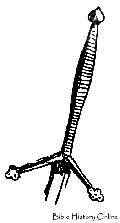
|
Claymore Or Scottish Sword Of The 15th Century
|
|
Claymore or Scottish sword of the 15th century, 3ft long. In the Warwick Castle. |
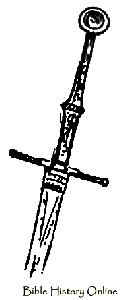
|
German Sword Of The 15th Century
|
|
German sword of the 15th century, 3ft 2 inches long. In the Museum of Munich. |

|
15th Century German Sword With Crystal Pommel
|
|
15th century German sword with crystal pommel, 38 inches long. In the Museum of Munich. |
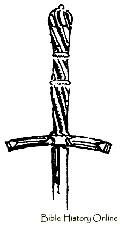
|
15th Century German Sword With Copper Pommel And Handle
|
|
German sword of the 15th century, 4 ft in length. The pommel and handle are of copper. In the Museum of Munich. |

|
15th Century Cutlass Sabre
|
|
15th century cutlass sabre, extremely large, about 3ft 10 inches in length, from an engraving. In the Cabinet of Engravings, Munich. |

|
15th Century German Sword Belonging To A Knight Of St George
|
|
15th century German sword, 3ft 10 inches long. Belonging to a knight of St. George. In the Imperial Arsenal of Vienna. |

|
15th Century Swiss Sword
|
|
15th century Swiss sword, with broad blade and quillon hilt and counter guard. 3 ft in length. |

|
Swords Of The End Of 15th Or Beginning Of 16th Centuries
|
|
Swords from the end of the 15th or beginning of the 16th centuries. In the Ambras Collection. |

|
Sword With A Calendar Of The Year 1506 Engraved On The Blade
|
|
Sword with handle and guard in gilded copper. A calendar for the year 1506 is engraved on the blade. In the Arsenal of Berlin. |
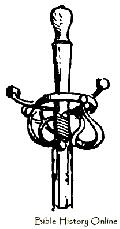
|
German Sword Of The 16th Century
|
|
German sword of the 16th century. with counter guard with five branches. 3ft 10 inches long. In the Museum of Artillery in Paris. |

|
Swiss Sword Belonged To reformer Zwinglius
|
|
Swiss sword made of iron, blade is 2ft 7 inches long and the handle about 9 inches long. It belonged to the reformer Zwinglius. In the Arsenal of Zurich. |

|
Greco Roman Bronze Sword
|
|
Greco-Roman sword in the British Museum. |

|
Dutch Sword Belonged To William The Silent
|
|
Dutch sword, with long, broad blade. It belonged to William the Silent, who was murdered in 1584. In the Arsenal of Berlin. |
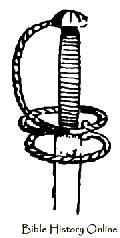
|
German Sword Belonging To A Lansquenet Of The 16th Century
|
|
German sword belonging to a lansquenet of the 16th century. Made of plain pattern with counter-guard, measures 2ft 11 inches, the blade 29 inches in length and 2 inches in breadth. In the Museum of Sigmaringen. |

|
Spanish Sword With Moorish Ornaments
|
|
Spanish sword with Moorish ornaments of the 16th century. Belonging to the collection of the Marquis of Villaseca and attributed by him to Boabdil, the last Moorish King of Granada. |
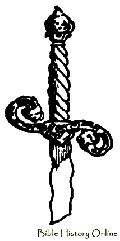
|
German Sword Of The 16th Century Manufactured At Augsburg
|
|
German sword of the 16th century, manufactured at Augsburg. 4ft 3 inches in length and the pommel and quillons are engraved. In the Museum of Sigmaringen. |
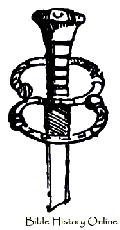
|
16th Century German Sword Belonging To A Lansquenet
|
|
16th century German sword belonging to a lansquenet, 2 1/2 feet long. The double guard, hilt and pommel are of iron with copper mountings. In the Museum of Carlsruhe. |

|
French Sword, Cut And Thrust
|
|
French sword, cut and thrust. 3ft 9 inches long with a slender blade in the style of the Spanish rapier blades. This sword either belongs to Henri II himself or to one of his courtiers. |
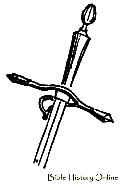
|
16th Century German Sword
|
|
16th century German sword. The blade has a double edge, narrow and with a ridge; the handle is made of black iron. The quillons are curved towards the point. In the Museum of Artillery in Paris. |

|
16th Century German Sword, Cut And Thrust
|
|
16th century German sword, cut and thrust. The blade has three ridges, two guards and a counter guard, the quillons are straight, the handle of shagreen. In the Museum of Artillery in Paris. |
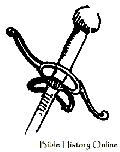
|
16th Century Sword With Spanish Blade
|
|
16th century sword with Spanish blade, bearing the mark of the armourer Alonzo de Sahagon of Toledo. In the Museum of Artillery in Paris. |
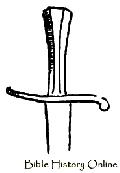
|
16th Century Tilting Sword
|
|
16th century tilting sword, from a picture of that period in the collection of the Count of Engenberg. |

|
16th Century German Sword Ornamented With Crucifix
|
|
16th century German sword ornamented with crucifix in high relief, 3ft 8 inches long. In the Museum of Sigmaringen. |

|
German Sword Of The 16th Century With Hilt Richly Inlaid With Silver Allegoric Figures
|
|
German sword of the 16th century. 3ft 6 inches in length, with hilt richly inlaid with silver allegoric figures representing the Danube, Rhine, etc., in the Museum of Sigmaringen. |
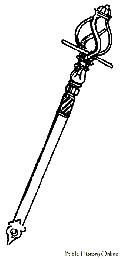
|
German Sword Of The 16th Century From The Description Of The Noces Princieres
|
|
German sword of the 16th century from the descriptions of the Noces Princiéres by Wirzig. In the Industrial Museum of Vienna. |

|
Sword Or Spanish Rapier From End OF The 16th Century
|
|
Sword or Spanish rapier from end of the 16th century. With basket hilt and straight quillons. In the Museum of Artillery in Paris. |

|
German Sword Inlaid With Gold And Enamelled
|
|
German sword, inlaid with gold and enamelled. From beginning of the 17th century. In the Museum of Sigmaringen. |

|
Sword Or Rapier
|
|
Sword or rapier. In the Museum of Paris. |
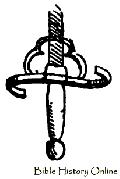
|
Outline Of A German Sword
|
|
Outline of a German sword, beginning of the 17th century. It is preserved in the Armeria of Madrid, where it is attributed to St. Ferdinand (1200-1252). |
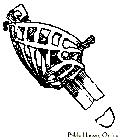
|
Venetian Sword Of The 17th Century
|
|
Venetian sword of the 17th century called schiavona. 2 feet, 9 inches long.In the Museum of Sigmaringen. |

|
17th Century Venetian Sword
|
|
17th century Venetian sword. In the Museum of Artillery in Paris. |

|
17th Century Cavalry Sword
|
|
Cavalry sword, end of the 17th century. In the Museum of Artillery in Paris. |
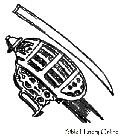
|
18th Century Scottish Cavalry Sword
|
|
18th century Scottish cavalry sword. In the Museum of Artillery in Paris. |

|
17th Century Savoyard Sword
|
|
Savoyard sword of the 17th century. It belonged to Captain Branaulieu-Chaffardin, who was killed in the walls of Geneva in 1602. In the Arsenal of Geneva. |

|
German Sword Of The 17th Century
|
|
German sword of the 17th century, grooved and measures 7 feet 2 inches in length, with quillons and pas d ane. In the Museum of Munich. |
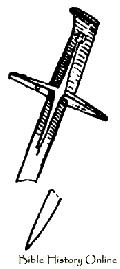
|
Sword Of 17th Or 18th Century
|
|
Sword of the latter years of 17th century or beginning of the 18th century. 5 feet 4 inches in length. In the Museum of Artillery in Paris and the Imperial Arsenal of Vienna. |

|
Cutlass Or Mariner Sword Of The 17th Century
|
|
Cutlass or mariner sword of the 17th century. With quillons and counter-guard. In the Museum of Erbach. |

|
Sword Of The 17th Century With Guard Covering The Back Of The Hand
|
|
Sword of the 17th century, with guard covering the back of the hand, and quillons the end of which are curved in opposite directions. |

|
Court Sword Of The Time Of Louis XV
|
|
Court sword of the time of Louis XV (1715-1774)in steel with gilt ornament and with pas d ane of a peculiar shape. In the Merville Collection. |
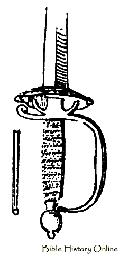
|
Court Sword Of The Time Of Louis XV In Polished Iron
|
|
Court sword of the time of Louis XV (1715-1774). In polished iron or steel cut in facets. In the Merville Collection. |

|
Court Sword Of The Time Of Louis XVI In Steel
|
|
Court sword of the time of Louis XVI (1778-1793), in steel. In the Merville Collection. |

|
Indian Sword Called Kunda De Rajah
|
|
16th century Indian sword called Kunda de Rajah. 3 feet 3 inches long and made entirely of iron. The blade is damascened, the handle, guard and hilt are beautifully ornamented with embossed and engraved work. |
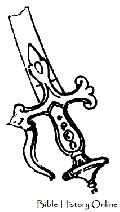
|
Indian Sword Called Johur De Rajah
|
|
Indian sword called Johur de Rajah, beginning of the 17th century. In the Museum of Tsarskoe-Selo. |

|
Nepaul Sword
|
|
Nepaul sword called Konkri Kora. In the Museum of Artillery in Paris. |

|
Hindoo-Mussulman Sword In Khorassan Damascened Work
|
|
Hindoo-Mussulman sword in Khorasan damascened work. The damascening of the blade is of a yellowish tint, which is the most esteemed. In the Museum of Artillery in Paris. |

|
Persian Sword From A Manuscript Of 1600
|
|
Persian sword from a manuscript of 1600, an illustrated copy of Schah Nameh. In the Library of Munich. |

|
Albanian Or Arnaut Sword
|
|
Albanian or Arnaut sword. Recognisable by the peculiar shape of the handle, which in other specimens is often ornamented with small chains. The handle and sheath of this weapon is inlaid with bright embossed silver, and the damascened blade is almost straight in shape. In the Museum of Artillery in Paris. |

|
Turkish Sabre Of Ancient Manufacture Of Constantinople
|
|
Turkish sabre with black damascened blade, of ancient manufacture of Constantinople. In the Museum of Artillery in Paris. |

|
17th Century Turkish Sabre
|
|
17th century Turkish sabre. In the Dresden Museum. |

|
Scimitar From A German Manuscript
|
|
Scimitar from a German manuscript, beginning of the 15th century. |

|
Turkish Scimitar
|
|
Turkish scimitar which differs greatly from the scimitars of the west in the shape of its guards, the end of which are curved towards the point of the sabre. This guard is in the shape of a heart. |

|
Chinese Scimitar
|
|
Chinese scimitar, a weapon easily known like almost all Chinese sabres by the absence of quillons, counter guard, pas d ane and basket hilt by the handle being corded and by the pommel which resembles the Chinese head-dress. |

|
Large Cutlass Or Mariner Sword
|
|
Large cutlass or mariner sword. 1 foot 4 inches long. In the Museum of Sigmaringen. |

|
Matador Sword
|
|
Matador sword with which the toreador on foot fights and kills the bull. The handle of this weapon is bound with a piece of red woollen braid. In the G. Arosa Collection at Paris. |

|
Ancient Japanese Yataghan
|
|
Ancient Japanese yataghan with damascened blade and rhinoceros horn handle, studded with dice-shaped ornaments. In the Museum of Artillery in Paris. |

|
Japanese Sabre With Curved Point
|
|
Japanese sabre with curved point, the handle is of carved wood, mounted with silver. In the Museum of Artillery in Paris. |

|
Japanese Sabre
|
|
Japanese sabre called Siobookatana. |

|
Chinese Sabre
|
|
Chinese sabre. |

|
Modern Chinese Sabre
|
|
Modern Chinese sabre, the handle is of white wood. It was part of the spoil taken from Pekin and is exhibited in the Museum of Artillery in Paris. |

|
Chinese Sabre Knife
|
|
Chinese sabre-knife, given to the condemn criminals to kill themselves with. In the Museum of Berlin. |

|
Turkish Yataghan With Blade Damascened In Gold
|
|
Turkish yataghan with blade damascened in gold. Taken from the Turks before Vienna in 1683. |

|
Kabyle Flissa With Handle Ornamented In Copper
|
|
Kabyle flissa, with handle ornamented with copper. It will be noticed that the flissa and yataghan resemble one another. |

|
Turkish Kandgiar
|
|
Turkish kandgiar. Horn handle, studded with copper, damascened blade. In the Museum of Artillery in Paris. |

|
Arab Sword
|
|
Arab sword, exhibited in the Museum of Artillery in Paris. The quillons are curved towards the blade, which is indented. |

|
Sword From Morocco With Rhinoceros Horn Handle
|
|
Sword from Morocco with rhinoceros horn handle. The guard is composed of three quillons, all curved towards the blade, also with counter-guard. |

|
Zanguebar Sword Single Edge
|
|
Zanguebar sword, 1 foot 10 inches long. The blade is single-edged, but has three grooves. The sheath and handle are in embossed or engraved copper, ornamented with precious stones. In Christy Collection, London. |

|
Large Zanguebar Sword With Crimped Leather Sheath
|
|
Large Zanguebar sword with crimped leather sheath. The haft, tapering towards the end and twisted forms a handle, which is without either guard or quillons. In the Museum of Artillery in Paris. |

|
Zanguebar Sword
|
|
Zanguebar sword. In the Museum of Artillery in Paris. |

|
Scythed Yataghan
|
|
Scythed yataghan of Tonarik manufacture. In the Museum of Artillery in Paris. |

|
Hatchet Yataghan
|
|
Hatchet yataghan of Tonarik manufacture. In the Museum of Artillery in Paris. |

|
Two-Handed Sword With Ring For Thumb
|
|
Two-handed sword, end of the 16th or beginning of the 17th century, as the curvature of the quillons towards the handle and the ring for thumb seem to indicate. In the Museum of Artillery in Paris. |

|
Swiss Two Handed Sword
|
|
Swiss two-handed sword, with curved and saw-edged blade, 15th century, about 4ft in length, the handle being 18 inches in length, the quillons are curved toward the blade. In the Arsenal of Berlin. |

|
15th Century Two Handed German Sword
|
|
Two handed German sword, end of the 15th century. This singular weapon, which is cutlass-shaped, is not straight. The blade and handle incline in opposite direction. In the Arsenal of Vienna. |

|
16th Century Two Handed German Sword
|
|
16th century two-handed German sword with cushions. In the Dresden Museum. |

|
15th Century Dagger
|
|
15th century dagger, of a shape also belonging to the 14th century. In the Arsenal of Vienna. |
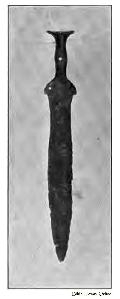
|
Etruscan Bronze Sword
|
|
Etruscan bronze sword in the British Museum. In the British Museum. |

|
Hunting Sword With Cross Piece
|
|
Hunting sword with cross-piece near the point of the blade, from the 16th century. in the Museum of Artillery in Paris. |



























































































































































